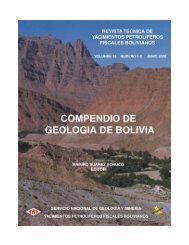Exploraciones por oro epitermal
You also want an ePaper? Increase the reach of your titles
YUMPU automatically turns print PDFs into web optimized ePapers that Google loves.
Corbett: Epithermal Gold For Explorationists<br />
Photo 9. Hadleigh Castle quartz-pyrite-galenasphalerite<br />
lode-sphalerite-galena-chalcopyrite<br />
Photo 10. Carbonate-base metal gold<br />
mineralization as sphalerite-galena-carbonate fill<br />
breccia from Kelian.<br />
Exploration Implications<br />
Several factors should be taken into account when attempting to use polymetallic Ag-Au alteration<br />
and mineralisation to vector towards <strong>por</strong>phyry Cu-Au mineralisation, even though the two styles<br />
commonly occur in the same district. Metal zonation in polymetallic ores may be complicated by<br />
repeated activity and telescoping. Dilatant structural environments may result in telescoping<br />
outwards of ore systems to form at considerable distances from intrusion ore sources. For instance,<br />
the Cadia Hill wall rock <strong>por</strong>phyry sheeted quartz veins (Photo 7) change little over 700 m vertical<br />
extent, without encountering any inferred source intrusion. Similar considerable ore trans<strong>por</strong>t is<br />
inferred for many polymetallic fluids (e.g., Cobar and Mineral Hill).<br />
Higher grade ores commonly occur within ore shoots along throughgoing structures with intervening<br />
subeconomic material (e.g., Bobbadah), and drilling should take this into account. Mineralisation<br />
commonly exploits pre-existing structures manifest as puggy faults which may not provide good<br />
ground conditions during mining of dipping veins.<br />
Carbonate-base metal gold<br />
Carbonate-base metal gold deposits represent the most prolific gold producers in the SW Pacific rim<br />
and are also present as undeveloped prospects (e.g., Porgera, Hidden Valley, Kerimenge, Upper<br />
Ridges, Edie Creek, Woodlark Is, Link Zone at Wafi, Mt Kare, Kelian, Mt Muro, Cikotok, Acupan,<br />
Antamok, Victoria at Lepanto, Bulawan, Penjom, Gold Ridge; Lake Cowal, Mt Leyshon and Kidston).<br />
Carbonate-base metal gold deposits generally occur at higher crustal levels than quartz-sulphide<br />
gold + copper systems, and typically comprise gangue of carbonate> quartz> pyrite> sphalerite><br />
galena> chalcopyrite (Photos 10 - 14), as fracture/vein/breccias (Corbett and Leach, 1998). Some<br />
carbonate-base metal gold deposits contain overprinting bonanza epithermal quartz gold-silver ores<br />
(e.g., Porgera), and others are also telescoped upon deeper level quartz-sulphide gold + copper<br />
mineralisation (Mt Kare, Photo 13). While in some instances several of these deposit styles may<br />
occur in one vein (e.g., Emperor, Tavatu, Photo 6), or other deposits display transitional relationships<br />
with quartz sulphide gold + copper ores (e.g., Lake Cowal, Kidston, Photo 15).<br />
Mineral deposition in carbonate-base metal systems is promoted by the mixing of rising mineralised<br />
fluids with bicarbonate waters and so gold occurs with a gangue of carbonate, pyrite, sphalerite and<br />
galena (Photos 10 - 15), which commonly display zonation depending upon the crustal level of the<br />
system (Corbett and Leach, 1998). For instance, sphalerite grades from dark Fe>Zn sphalerite<br />
formed at depth in hotter conditions (Photo 10), through red, honey to clear, Fe
















